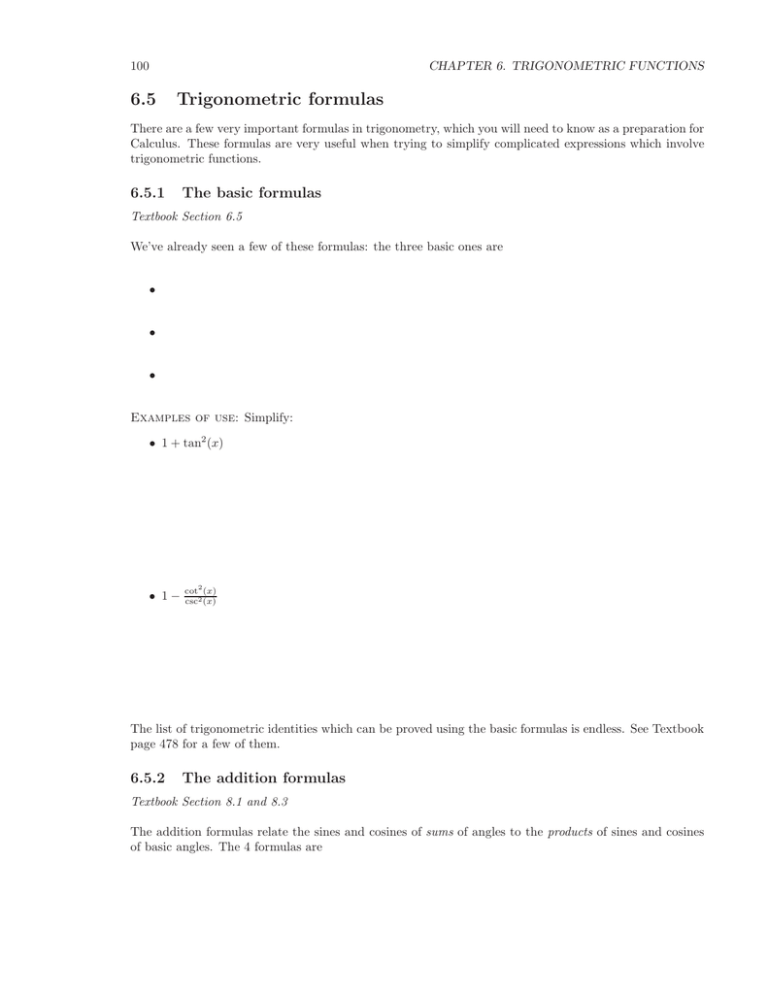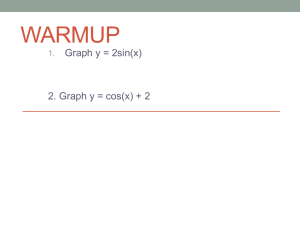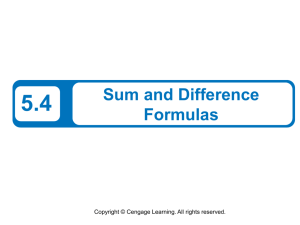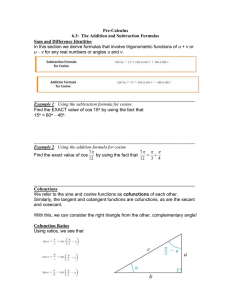6.5 Trigonometric formulas
advertisement

100 6.5 CHAPTER 6. TRIGONOMETRIC FUNCTIONS Trigonometric formulas There are a few very important formulas in trigonometry, which you will need to know as a preparation for Calculus. These formulas are very useful when trying to simplify complicated expressions which involve trigonometric functions. 6.5.1 The basic formulas Textbook Section 6.5 We’ve already seen a few of these formulas: the three basic ones are • • • Examples of use: Simplify: • 1 + tan2 (x) • 1− cot2 (x) csc2 (x) The list of trigonometric identities which can be proved using the basic formulas is endless. See Textbook page 478 for a few of them. 6.5.2 The addition formulas Textbook Section 8.1 and 8.3 The addition formulas relate the sines and cosines of sums of angles to the products of sines and cosines of basic angles. The 4 formulas are 6.5. TRIGONOMETRIC FORMULAS 101 • • • • Examples: These examples show that these formulas indeed work: • cos(π/3 − π/6) • cos(π/3 + π/3) • sin(π/4 + π/4) Also, they confirm our hunch that sin(x) and cos(x) are the “same” function but displaced by π/2. Indeed, But where do these formulas come from? Proving the last one will be done in Section, and the others can be deduced from it... Note: There is no equivalent product formulas: there is no simple identity for cos(ab) and sin(ab). On the other hand, the addition formulas can be used backward to prove the following identities: 102 CHAPTER 6. TRIGONOMETRIC FUNCTIONS Alltogether these identities can be used to prove another nearly-infinite number of identities... for example sin(a − b) sin(b − c) sin(c − a) + + =0 cos(a) cos(b) cos(b) cos(c) cos(c) cos(a) 6.5.3 The double-angle formulas Textbook Section 8.2 As a consequence of the addition formulas, we have 3 more formulas which are called the double-angle formulas because they express the sine and cosine of the angle 2a in terms of the sine and cosine of the angle a. These formulas are • • • To show them, note that 6.5. TRIGONOMETRIC FORMULAS Again, these double-angle formula can be used to simplify trigonometric expressions: for example sin(2x) cos(2x) − = sec x sin(x) cos(x) Indeed 6.5.4 Summary Of the various formulas above, only a few have to be known by heart: • The definition of the various functions: • The Pytagorean identity: • The symmetry property: • The periodicity property: • The phase-shift property: • The 2 double-angle formulas: 103 104 CHAPTER 6. TRIGONOMETRIC FUNCTIONS All of the other formulas can be recovered from combining these ones – so don’t clog your memory with formulas... In what follows, we will now use these formulas to solve equations involving trigonometric functions. 6.6 Solving trigonometric equations Textbook Section 8.4 The formulas studied earlier will now be used to first simplify, and then actually solve trigonometric equations. Let’s work by examples. Example 1: Solve the equation sin(2x) = cos(x) This example illustrates two steps: using the standard formulas to simplify an equation, and using the unit circle to find how many solutions there are. Another way of doing the second step is to graph the simplified equation: Example 2: Solve the equation sin(3x) = √ 3 2 6.6. SOLVING TRIGONOMETRIC EQUATIONS 105 This example illustrates that you must be very careful in not forgetting the extra solutions coming from the +2kπ part of the original solution. Example 3: Solve the equation cos2 (x) + cos(x) − 2 = 0 Example 4: Solve the equation | sin(x)| = | cos(x)| This equation illustrates the use of the unit circle to solve trigonometric equations and visulalize the solutions... Example 5: However, not all trigonometric equations can easily be solved analytically using these methods. As a last example, let’s investigate: 3 sin(x) = 1 106 CHAPTER 6. TRIGONOMETRIC FUNCTIONS This illustrates the need to introduce inverse trignometric functions 6.7 The inverse trigonometric functions Textbook Section 8.5 Definitions: We define the three basic inverse trigonometric functions: Horizontal line test? However, note how neither of the three basic trigonometric functions pass the horizontal line test. As a consequence, the domain of definition of the inverse functions is limited to a region where the function does. For the sin(x) function and its inverse: 6.7. THE INVERSE TRIGONOMETRIC FUNCTIONS 107 For the cos(x) function and its inverse: For the tan(x) function and its inverse: As for any function and their inverse, f (f −1 (x)) = f −1 (f (x)) = x so we have: What is interesting, however, is to combine the Pythagorean theorem with the inverse equations to get sin(cos−1 (x)) and cos(sin−1 (x)): 108 These will be used a lot in Calculus! CHAPTER 6. TRIGONOMETRIC FUNCTIONS






